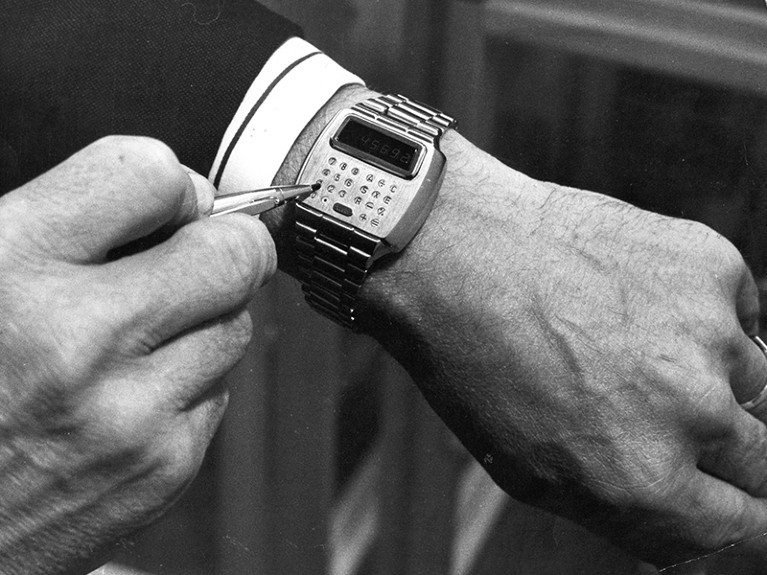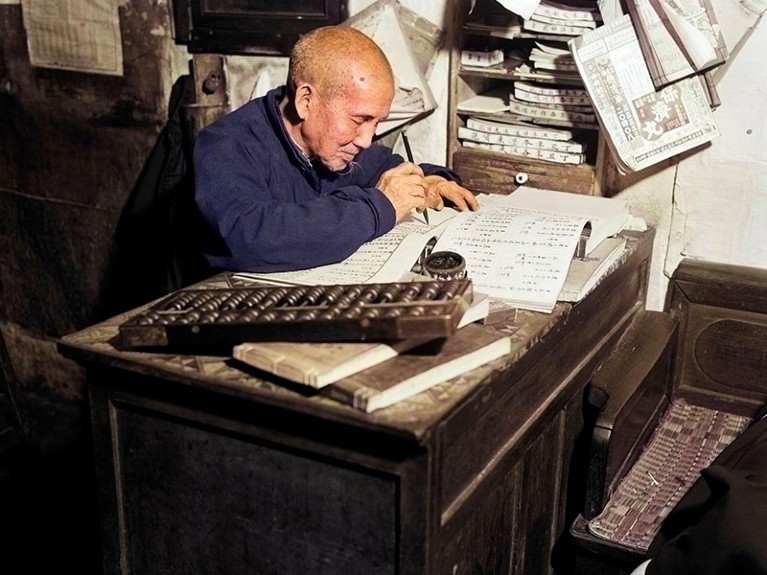
Pulsar, the first computer–calculator and wristwatch, at a trades fair in London in 1977.Credit: Malcolm Clarke/Getty
Empire of the Sum: The Rise and Reign of the Pocket Calculator Keith Houston W. W. Norton (2023)
As a child during the late 1970s and early 1980s, I recall some of my classmates coming to school sporting digital watches with built-in calculators. With their microscopic buttons and tiny liquid-crystal displays, these devices were the acme of cool: as well as doing maths on their wrists, the kids could also play Space Invaders. Those watches were a step up from the drab, utilitarian boxes that could then be spotted on desks everywhere, from homes to schools.
As it turns out, pocket calculators were the culmination of thousands of years of human history and innovation, which software developer Keith Houston describes in his book, Empire of the Sum. Walking readers from a 42,000-year-old counting aid to digital spreadsheets, the book provides a breezy mathematical history tour through the development of number systems, slide rules, mechanical calculators and microchips.

Humans and algorithms work together — so study them together
The book is filled with well-known names, including inventor Thomas Edison, who refined the lightbulb and laid the groundwork for vacuum tubes; physicist Isaac Newton, who, in addition to calculus, developed the slide rule’s movable ‘cursor’; Blaise Pascal, the French philosopher and mathematician who invented a mechanical calculator called the Pascaline; and Katherine Johnson — a NASA ‘computer’ who calculated orbits and landing trajectories and, among other missions, was instrumental in sending US astronaut John Glenn into space in the 1960s. In explaining their contributions, Empire of the Sum is chock-a-block with historical details.
I remember learning in primary school that the reason humans use a base-10 system is because we have 10 fingers. But not all societies count like that. Millennia ago, Sumerians used base-60, probably by combining the left hand’s 12 finger joints (the thumb was used to point) with the right hand’s five fingers. That counting method is still echoed today, Houston notes: “It is no coincidence that a clock has twelve hours, an hour has sixty minutes, and a minute has sixty seconds.” At the turn of the twentieth century, the Indigenous Melanesian people of the Torres Straits Islands, between Australia and Papua New Guinea, were found to be using a base-19 system: 5 fingers from each hand, plus the wrists, elbows, shoulders, nipples and sternum.
Houston takes us from the bead-based abacuses of ancient Babylon, Greece and China, to slide rules, which exploit the principle that numbers can be multiplied by adding their logarithmic equivalents (for example, 4 × 8 = 22 23 = 25 = 32). Both devices had an enviably long lifespan. Invented in the first millennium bc, abacuses were still being used in Japanese schools in the 1970s. And slide rules, invented in the seventeenth century, were still available during the 1980s.

A Chinese bookkeeper using an abacus in 1925.Credit: Alamy
Slide rules helped engineers to build fighter planes and went to the Moon on Apollo 11. They were used to design bridges, and to estimate the weight of cattle from their length and girth. But because they were only as precise as the user’s eyesight, and induced people to reduce all problems to the most basic of operations, they also had a degree of uncertainty. As a result, Houston writes, “bridges were built stronger, and more expensively, than they had to be. Planes were heavier and slower. Cars burned more gas. Oceans of nuance and complexity were erased.”
Also discussed are mechanical calculators — the marriage of clock-making with mathematics — and the human ‘computers’, many of them women, who used them. The Mathematical Tables Project, for example, led in the 1930s and 1940s by mathematician Gertrude Blanch, saw hundreds of clerks cranking out table upon table of mathematical values, in a US government work-creation programme during the Great Depression. Austrian engineer Curt Herzstark, born to a Jewish father, was sent to the Buchenwald concentration camp during the Second World War and forced to build components for Germany’s V2 rocket programme. While there, he dreamed up an elegant, portable mechanical calculator that he was able to bring into existence shortly after the war ended: the peppermill-like Curta Type I, which US author William Gibson called a “math grenade”. Unfortunately for Herzstark, the Curta would arrive just in time for mechanical calculators to become obsolete owing to the burgeoning computer age.

How to introduce quantum computers without slowing economic growth
The second half the book covers the rapid-fire development of electronic calculators, built first from vacuum tubes and relays, and then from transistors and microchips. Texas Instruments, Japan’s Casio and other electronics juggernauts vied for dominance in a fast-shifting landscape of technological development and corporate cross-pollination. In an interesting aside, we learn that many of the algorithms underlying the Hewlett-Packard HP-35, the world’s wildly successful first pocket scientific calculator, launched in 1972, were created originally to drive the navigational systems of cold war-era bomber aircraft.
Empire of the Sum ends not with a physical calculator but with US software publisher VisiCorp’s VisiCalc, the first computer spreadsheet program, which was so powerful that it inspired people to purchase home computers just to use it. Before the program’s launch in 1979, the spreadsheet was a physical object: an extended piece of paper on which accountants could track debits and credits. VisiCalc’s designer, designer Dan Bricklin, then a student at Harvard University in Cambridge, Massachusetts, transformed that into a computational interface that allowed users to input numbers, perform calculations and propagate those changes from cell to cell. In doing so, he helped make computers indispensable — and pocket calculators largely redundant.
Between market saturation and the growing computer industry, by the 1980s, consumer attention was increasingly turning away from calculators and towards desktop and eventually mobile computers. Still, the pocket calculator lives on, in classrooms, in kitchen drawers and as applications on smartphones. “The calculator is dead, long live the calculator,” Houston concludes. As Empire of the Sum documents, it had one hell of a reign.
